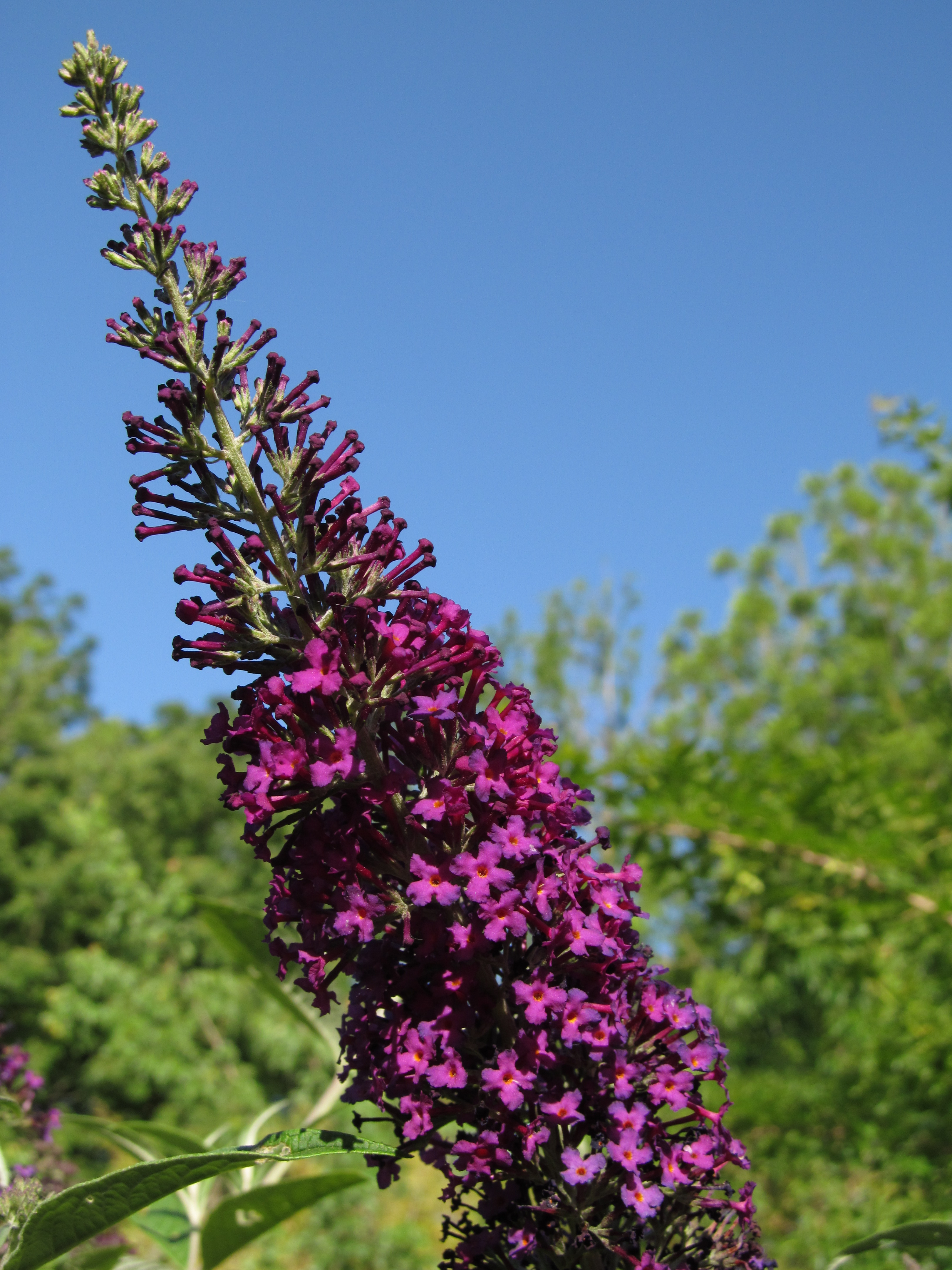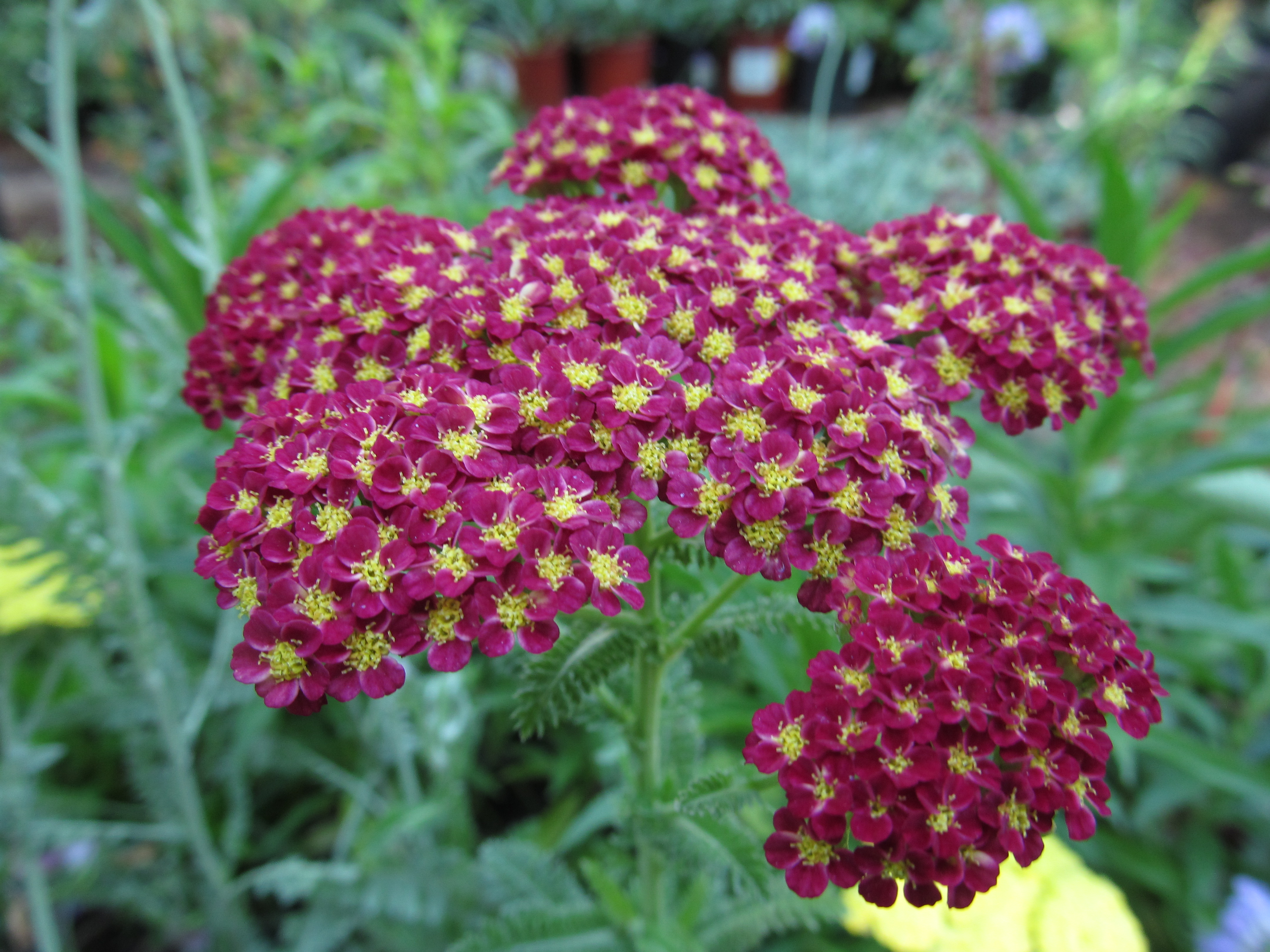Ten Plants for Early Summer!
Written for the Davis Enterprise, May 31, 2012
Click on any image for a larger version
Slide show of the plants in this article: Click here
As we head into summer, gardeners may be looking for plants that give lots of landscape value with little input. For ease of growth, abundance of bloom, and interesting foliage, here are ten plants I keep coming back to in the months of May and June for garden performance.

Buddleia is the genus of Butterfly bushes, a group of shrubs tolerant of sun, heat, and moderate drought. Old types grow 6 feet tall or more, and benefit from a hard pruning every year of so. Royal Red, shown here, isn't really red: it is purple with a tinge of red in each small blossom. Fragrant, free-blooming, and very attractive to hummingbirds as well as butterflies.
 Canna lilies are noted for their bold, tropical foliage and gaudy flowers. They spread by rhizomes to make large patches. Tropicana has especially attractive striped, colorful leaves, and vivid orange flowers.
Canna lilies are noted for their bold, tropical foliage and gaudy flowers. They spread by rhizomes to make large patches. Tropicana has especially attractive striped, colorful leaves, and vivid orange flowers.
 Oakleaf hydrangea is becoming one of my favorite shrubs for shady landscape areas. Elegant growth habit, attractive foliage, nice fall color, clean white blooms. A great substitute for the standard hydrangea, which doesn't like our water.
Oakleaf hydrangea is becoming one of my favorite shrubs for shady landscape areas. Elegant growth habit, attractive foliage, nice fall color, clean white blooms. A great substitute for the standard hydrangea, which doesn't like our water.
 Honey bush is a big, dramatic plant in the landscape! It can tolerate sun or light shade. Interesting for large containers as well.
Honey bush is a big, dramatic plant in the landscape! It can tolerate sun or light shade. Interesting for large containers as well.
 Penstemon, sometimes called Beard tongue, is a summer-blooming perennial that is attractive to hummingbirds and large solitary bees. Newer hybrids may have brighter, splashier colors, but Midnight is a proven performer in Valley landscapes. Plants shown here are three years old: 3 feet across and tall, blooming from May through July.
Penstemon, sometimes called Beard tongue, is a summer-blooming perennial that is attractive to hummingbirds and large solitary bees. Newer hybrids may have brighter, splashier colors, but Midnight is a proven performer in Valley landscapes. Plants shown here are three years old: 3 feet across and tall, blooming from May through July.
 Jerusalem sage isn't a true sage, but it's a close cousin. A big plant for sunny locations, growing to 4 feet tall and 5 feet across, but readily trimmed for size. Fragrant blossoms, easy to root, easy to grow.
Jerusalem sage isn't a true sage, but it's a close cousin. A big plant for sunny locations, growing to 4 feet tall and 5 feet across, but readily trimmed for size. Fragrant blossoms, easy to root, easy to grow.
We need to start thinking of pomegranate trees for their ornamental value! The flowers are large and showy in May, fall leaf color is bright yellow, and the fruit is bright and colorful in fall. I water my pomegranate tree about once a month. The fruit is delicious, and if you don't happen to eat it the songbirds will.
 The variety shown here is Strawberry Seduction, which blooms at about 18 inches tall from summer through early fall. Yarrows attract beneficial insects, make lovely dried flowers, and spread slowly by short rhizomes. Full sun is best.
The variety shown here is Strawberry Seduction, which blooms at about 18 inches tall from summer through early fall. Yarrows attract beneficial insects, make lovely dried flowers, and spread slowly by short rhizomes. Full sun is best.
1. Buddleia Royal Red (Butterfly bush)
Butterfly bushes draw butterflies, hummingbirds, and bees. They have fragrant flowers, and are reasonably drought tolerant. The new Buzz Buddleias are dwarf, fitting into smaller yards and borders. But I still think Royal Red, which is actually purplish-red, is one of the best for its vibrant color.
2. Canna Tropicana (Canna lily)
I don't even really like Canna lilies for the most part. Ok, they impart a bold, tropical look, but they can look pretty scruffy after the bloom, and the rhizome roots keep pushing outward to make unwieldy-size clumps. But Tropicana has beautiful striped leaves. Great in containers, near water features, or in a border deep enough to accommodate some spread. The bright orange flowers are a nice bonus.
3. Cotinus coggygria (Smoke bush)
This is becoming one of my favorite small trees for patios, dry landscapes, and hot locations. Royal Purple has the most vivid colored leaves. A great substitute for the ubiquitous red-leaf plum, with a more graceful, open habit, and more tolerant of drought. The flowers are in wispy clusters, causing a "smoke" effect. There is also a gold-leaved variety.
4. Hemerocallis Gentle Shepherd (Daylily)
More than 60,000 cultivars of daylily to choose from, and I like this white one? Yes! The clean, creamy-white, very large blossoms are a departure from the usual oranges, reds, and yellows of daylilies, blending with any other color in the landscape. But there are gaudier colors if you prefer. Anybody can grow daylilies!
5. Hydrangea quercifolia (Oakleaf hydrangea)
Grandma's mophead hydrangeas, the giant-flowered types in pink or blue, are fussy in Davis. They get anemic due to the water quality, and require lots of water. The white-flowered Oakleaf hydrangea is a very elegant substitute. It doesn't care about the pH of our water, the foliage is very attractive (and turns a nice red color in fall), and the plant is much more refined than the mopheads. Prefers afternoon shade.
6. Lavandula x intermedia Grosso (Lavandin, hybrid lavender)
Lots of lavenders to choose from, but I especially recommend this one for fragrance and heavy bloom yield. It grows 3 to 4 feet tall and broad. All lavenders are heat-loving and drought-tolerant; in fact, it is easy to over-water them. Keep them dry once established. Grosso, like many of the hybrid lavenders, blooms from May through summer, often into fall.
7. Melianthus major (Honey bush)
Big bold-toothed grey-green leaves, mahogany-colored flower spikes in May. The foliage smells odd, not unpleasant; some say like pasta. Tolerates hot sun, partial shade, drought. Sprawls several feet across if allowed to, but can be cut back periodically for size control.
8. Penstemon heterophyllus Midnight (Summer snapdragon)
Penstemon is one of my favorite perennials, and Midnight is my favorite penstemon. Some varieties aren't long-lived; this one is. I have one plant that is more than ten years old. This is one of those May through July perennials, but it will give another fall bloom if you remove spent bloom spikes. Hummingbirds and the big solitary bees love penstemons of all kinds. Full sun or partial shade, tolerant of drought or average watering. Give 'em room: each of my plants is about 3 feet across.
9. Phlomis fruticosa (Jerusalem sage)
This is a big, sprawling shrub with attractive fuzzy grey-green leaves and strange, beautiful yellow flowers in whorls over a long period. The flowers smell exactly like carnations! Very drought tolerant, very sun tolerant, moderately shade tolerant. Branches can be allowed to root if you want it to cover territory. If not, cut it back now and then.
10. Punica granatum (Pomegranate)
One of the easiest fruit trees to grow, pomegranates always remind me in May and June how attractive they are in the landscape as they sport large, bright orange-red flowers. Then they remind me again in fall as the leaves turn bright yellow and the vivid red fruit ripens. Even if you don't eat the fruit, it is a beautiful landscape shrub or small tree. Pest-free, drought and heat tolerant. Dwarf varieties that set miniature fruit are useful landscape ornamentals.
-- runners up --
11. Achillea (yarrow): lots of new varieties with shorter stature and brighter colors have brought this old perennial back in popularity.
12. Alstroemeria (Peruvian lily): finding new use as a garden perennial, rather than just for cutting, due to a whole spate of new compact varieties.
13. Celosia (Plume flower and cockscomb): psychedelic color range, strange crested forms make these sun-loving annuals favorites for kids.
14. Euphorbia Ascot Rainbow: colorful foliage, chartreuse flowers, compact habit, full sun. Great with succulents.
15. Phygelius capensis (Cape fuchsia): elegant hanging flowers on tall open spikes attract hummingbirds all summer. Not a fuchsia! Much easier and hardier.
We get questions.
Have you found any new control measure for the worm that gets in cherries?
No. The wriggling, writhing worms that showed up in ripening cherry fruit a couple of years ago are now everywhere. Based on feedback from gardeners and other professionals, I now consider the Spotted wing drosophila to be an unmanageable pest for home gardeners, and no longer recommend sweet cherry trees in the Sacramento Valley. Sorry.
Why are the growing shoots of my rose bush withering and curling? Just some of them, here and there, not the whole plant?
The raspberry horntail borer deposits her egg on the stem. The larva bores into the cambium and begins working its way downward. After a couple of inches it has blocked the water-conducting tissue and everything above that point wilts abruptly. It's a problem in May, mostly gone by summer. Just prune it out.
Why are the blossoms of my tomato plants falling off without setting fruit?
Cool night temperatures or high daytime temperatures are usually to blame. Blossoms will drop below about 55F at night, and above about 90 in the daytime. Fortunately we have a lot of summer days and nights in the right temperature range.
Why is my cilantro flowering? I need it later for my salsa!
Cilantro likes even, moderate, cool temperatures. Too hot, it flowers and goes to seed (which is coriander, so it's still usable). Plant cilantro in fall or early spring.
What's this I hear about a new disease on Impatiens?
Yes, a new strain of downy mildew has hit Impatiens, America's favorite bedding plant. First signs are white powder on the undersides of the leaves, then death of individual plants and decimation of all the plants. This disease is very destructive, and is showing up on Impatiens in many locations across the country.
Part of the problem is that the bedding plants you buy originated from central growers elsewhere, and the disease doesn't show up until after planting. Specific to the bedding Impatiens, it doesn't affect New Guinea types, or other shade annuals. Unfortunately, it remains in the soil for a couple of years. So if you get it, plant something else for a couple of seasons. Bedding begonias and coleus are great annuals for the shade.
© 2011 Don Shor, Redwood Barn Nursery, Inc., 1607 Fifth Street, Davis, Ca 95616
www.redwoodbarn.com
Feel free to copy and distribute this article with attribution to this author.
Click here for Don's other Davis Enterprise articles
